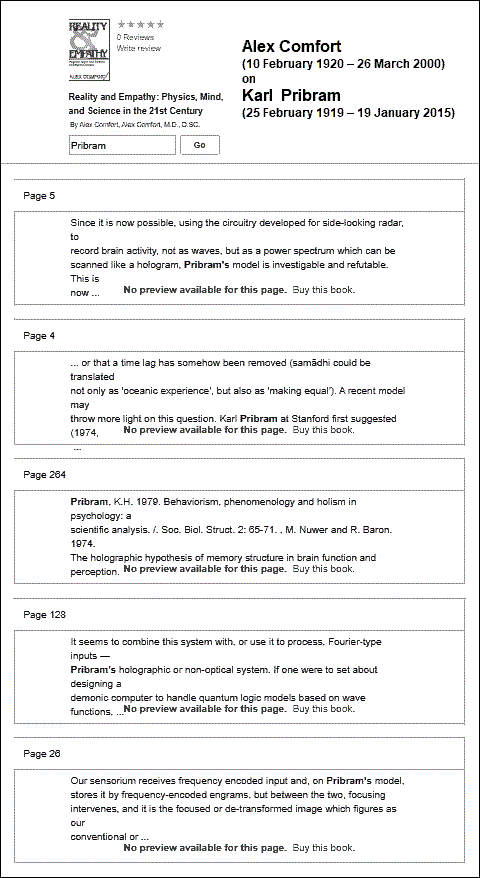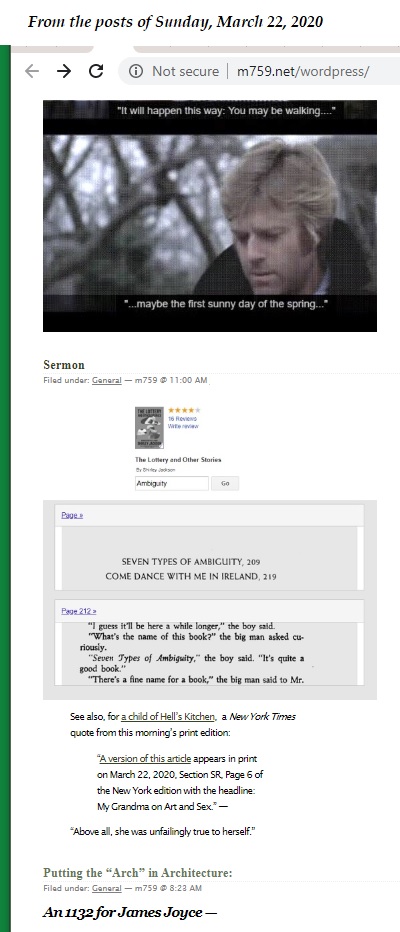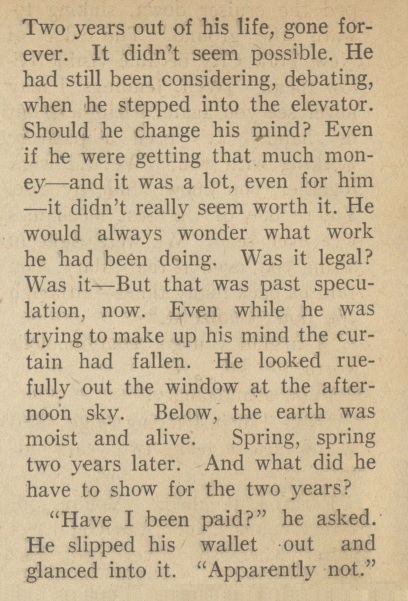This post was suggested by a New York Review of Books article
on Cologne artist Gerhard Richter in the May 14, 2020, issue —
“The Master of Unknowing,” by Susan Tallman.

Some less random art —
This post was suggested by a New York Review of Books article
on Cologne artist Gerhard Richter in the May 14, 2020, issue —
“The Master of Unknowing,” by Susan Tallman.

Some less random art —
See the web pages octad.group and octad.us.
Related geometry (not the 759 octads, but closely related to them) —
The 4×6 rectangle of R. T. Curtis
illustrates the geometry of octads —
Curtis splits the 4×6 rectangle into three 4×2 "bricks" —
 .
.
"In fact the construction enables us to describe the octads
in a very revealing manner. It shows that each octad,
other than Λ1, Λ2, Λ3, intersects at least one of these ' bricks' —
the 'heavy brick' – in just four points." . . . .
— R. T. Curtis (1976). "A new combinatorial approach to M24,"
Mathematical Proceedings of the Cambridge Philosophical Society ,
79, pp 25-42.
From the subtitles of the recent Kristen Stewart film “Underwater” —
427
00:30:26,144 –> 00:30:27,476
He’d always say
he had a new joke,
428
00:30:27,478 –> 00:30:29,445
and then he’d tell
the same stupid joke.
429
00:30:29,447 –> 00:30:32,785
I was… laughing at that joke.
430
00:30:34,053 –> 00:30:35,685
Yeah, what was it?
431
00:30:35,687 –> 00:30:38,654
What did the fish say when
it bumped into the brick wall?
April 11 was the dies natalis , in the Catholic sense, of John Horton Conway.
Related material: Other posts containing the phrase “brick wall.”
The title is of course from an old joke about mystic philosophies.
Related remarks by John Archibald Wheeler —
“Remarkable issues connected with the puzzle of existence
confront us today in Hermann Weyl’s domain of thought.
Four among them I bring before you here as especially interesting:
(1) What is the machinery of existence?
(2) What is deeper foundation of the quantum principle?
(3) What is the proper position to take about the existence of
the “continuum” of the natural numbers? And
(4) What can we do to understand time as an entity, not precise and
supplied free of charge from outside physics, but approximate and
yet to be derived from within a new and deeper time-free physics?
In brief, how come time?
What about the continuum?
How come the quantum?
What is existence?”
— John A. Wheeler, “Hermann Weyl and the Unity of Knowledge,”
American Scientist 74, no. 4 (1986): 366–75. Reprinted in
John A. Wheeler, At Home in the Universe
(American Institute of Physics, December 1, 1995).
The above bibliographic data is from . . .
Schrank, Jeffrey. Inventing Reality: Stories We Create To Explain Everything .
Gatekeeper Press. Kindle Edition, March 14, 2020.
For further scholarly details, see a version at JSTOR:
“…the article is adapted from the concluding address given at
the Hermann Weyl Centenary Congress, University of Kiel, 3 July 1985.”
— https://www.jstor.org/stable/27854250.
I prefer Charles Williams on “the Unity of Knowledge.”
See the 15 instances of the phrase “the Unity” in his 1931 novel Many Dimensions .
|
A doodle from 2012’s Feast of the Epiphany—
A doodle based on a post for Twelfth Night, 2003—
|
Click here to enlarge. See also Hexagram 59, Feng Shui.
For some mathematical background, see Deep + Hardy.
Related entertainment —

Related non-entertainment —

The Tesseract Timeline:
Where The Cube Has Been In The …
www.cinemablend.com › news › the-tesseract-timeline-…
Mar 13, 2019 – With HYDRA. In 1942, Johann Schmidt, a.k.a.
the Red Skull, arrived in Tønsberg to procure the Tesseract
from an ancient church. While he …
Related material from posts tagged Aqua
(suggested by a name in the previous post) —
From Atomicity and Quanta by James Jeans,
Cambridge University Press, 1926, pp. 55-56 —
| “So far as we can at present conjecture, the investigation of the structure which produces this atomicity appears to be the big problem in the path of the quantum-theory. To conform to the principle of relativity, the new atomicity must admit of expression in terms of the space-time continuum, although we have seen that it cannot be an atomicity of the continuum itself. It may conceivably be an atomicity of its metric properties, such as determine its curvatures. We may perhaps form a very rude picture of it by imagining the curvature of the continuum in the neighbourhood of an atom not to be of the continuous nature imagined by Weyl, but to occur in finite chunks—a straight piece, then a sudden bend, then another straight bit, and so on. A small bit of the continuum viewed through a five-dimensional microscope might look rather like a cubist picture; and, conversely, perhaps a cubist picture looks rather more like a little fragment of the continuum than like anything else.” |
This is, of course, not the “atomicity” of the previous post.
For examples of that atomicity, a concept of pure geometry
rather than of physics, see …
Faure, C. A., and Frölicher, A., “Fundamental Notions of
Lattice Theory,” in Modern Projective Geometry (2000).
(Mathematics and Its Applications, vol 521. Springer, Dordrecht.)
Related art (a “cubist picture”) —
Juan Gris, Fruit Dish and Carafe , 1914
“Where there is meat, there are flies.”
— John Archibald Wheeler
|
“ Simon’s head was tilted slightly up. ‘What are you doing out here all alone? Simon shook. ‘There isn’t anyone to help you. — William Golding |


See also the previous post.
The above date “4 avril 2016”
suggests a review of that date
in this journal: “Cube for Berlin.”
“But while Camus was writing for the moment,
he was also writing for the future. He was making art
out of what happens between antibodies and germs,
expanding metaphors from the molecular level.”
— Laura Marris on translating The Plague
Another remark on dramatic irony —
See as well “two-way mirror” in this journal.
The above title was suggested by the previous post, Explosive Remarks.

“Here is the background to Wheeler’s explosive remarks.
John Archibald Wheeler, director of the Center
for Theoretical Physics at the University of Texas,
is one of the world’s top theoretical physicists.
In 1939 he and Niels Bohr published a paper on
‘The Mechanism of Nuclear Fission”
that laid the groundwork for atomic and hydrogen bombs.
Wheeler later played major roles in their development.”
For a rather different explosion of Wheeler’s views, see the previous post.
“In his big book, Gravity [sic ], Wheeler puts our space
into what he calls superspace, and speculates on the
most basic physical laws which operate on superspace.
He comes to the (to me) surprising conclusion that the
rock-bottom laws are the laws of the propositional calculus!”
— Martin Gardner, letter to Donald E. Knuth, 8 January 1976,
on cover of Notices of the American Mathematical Society ,
March 2011 issue.
Fact check —

Related reading —


“A love story of epic, epic, epic proportion” — Kristen Stewart
See also the following letter to Knuth on four-color enthusiast
Spencer-Brown, as well as Tim Robinson on the same subject
in his book My Time in Space .
In memory of the author of My Time in Space * —
Tim Robinson, who reportedly died on April 3 —
See also an image from a Log24 post, Gray Space —
Related material from Robinson’s reported date of death —
* First edition, hardcover, Lilliput Press, Ireland, April 1, 2001.
A post by David Justice today suggests a review —
A more literary approach to refutation —
|
“He is real,” said the boy, passionately. “He’s not a fool. He’s real.” “Listen,” said his father. “When you go down the garden there’s nobody there. Is there?” “No,” said the boy. “Then you think of him, inside your head, and he comes.” “No,” said Small Simon. “I have to make marks. On the ground. With my stick.” “That doesn’t matter.” “Yes, it does.” — John Collier, “Thus I Refute Beelzy.” |
Stephen Wolfram yesterday —
“Causal invariance may at first seem like a rather obscure property.
But in the context of our models, we will see in what follows that
it may in fact be the key to a remarkable range of fundamental features
of physics, including relativistic invariance, general covariance, and
local gauge invariance, as well as the possibility of objective reality in
quantum mechanics.”
From . . .
Church Diamond Continued
The above article leads to remarks by Stephen Wolfram published today :
See also “Invariance” as the title of the previous post here.
Note the resemblance to Plato’s Diamond.
Click the Pritchard passage above for an interactive version.
The May 2020 Notices of the American Mathematical Society has a
memorial tribute article on Goro Shimura, who died on May 3, 2019.
See also this journal on May 3, 2019 in posts now tagged Wondertale.
Related ethnic remark: “As a Chinese jar…” — T. S. Eliot
“Things can get muddled further….”
— Webpage on the Japanese word
Indeed they can :
See also this journal on November 29, 2011 —The Flight from Ennui.
Related illustration from earlier in 2011 —
See also this journal on 20 Sept. 2011 — Relativity Problem Revisited —
as well as other posts tagged Congregated Light.
From a post this morning by Peter J. Cameron
in memory of John Horton Conway —
| ” This happened at a conference somewhere in North America. I was chairing the session at which he was to speak. When I got up to introduce him, his title had not yet been announced, and the stage had a blackboard on an easel. I said something like ‘The next speaker is John Conway, and no doubt he is going to tell us what he will talk about.’ John came onto the stage, went over to the easel, picked up the blackboard, and turned it over. On the other side were revealed five titles of talks. He said, ‘I am going to give one of these talks. I will count down to zero; you are to shout as loudly as you can the number of the talk you want to hear, and the chairman will judge which number is most popular.’ “ |
Thursday, August 21, 2014
NoxFiled under: Uncategorized — m759 @ 1:00 AM ( A sequel to Lux ) “By groping toward the light we are made to realize — Arthur Koestler, The Call Girls: A Tragi-Comedy ,
Robin Williams and the Stages of Math i) shock & denial A related description of the process — “You know how sometimes someone tells you a theorem, — Tom Leinster yesterday at The n-Category Café |
“… the Jesuit religious order, whose intensive, extensive ordination process
typically takes about 10 years”
— The above link in The New York Times today leads to . . .
For the Church of Synchronology —
A post in this journal on the above Jesuit date — Aug. 11, 2013 —
leads to a John Hurley at Wolfram Demonstrations . . .
This may or may not be the John Hurley described in the
LinkedIn page below (click for further details):
“All the schools of philosophy, from ancient Greece to the Enlightenment
encyclopedists, have dreamt of one day arriving at total and definitive
knowledge, a knowledge that encompasses the world. Indeed, the dream
lives on in the minds of some scientists today.”
— “Does Basic Research Have Meaning?” by Laurent Lafforgue —
“La recherche fondamentale a-t-elle un sens?
Quelques remarques d’un mathématicien catholique,”
Conférence donnée à l’Université de Notre-Dame,
aux États-Unis, le 20 mai 2011. Voici la version anglaise
de cette conférence (traduite par Hélène Wilkinson)
Et voici Larkin in Devs —

See too “musical brocade” in this journal.
“At the spiritual level, the biggest oeuvre (in my eyes)
accomplished by a man, was the Passion
of the Christ and his death on the cross…”
— Quotation said to be by Grothendieck, replying to
a 1987 letter from Juan Antonio Navarro González .
The quotation is from . . .

See “Pleasantly Discursive” in this journal.

For the Toro , see Pierre Cartier in 2001 on the barber of Seville and
“The evolution of concepts of space and symmetry.”
For the Torino , see . . .
“… the ultimate goal of the present essay
which is to illustrate the historic
evolution of the concepts of Space and Symmetry “
— Pp. 157-158 of the above book.
See also Fré et al. , “The role of PSL(2,7) in M-theory”
(2018-2019) at http://arxiv.org/abs/1812.11049v2 ,
esp. Section 4, “Theory of the simple group PSL(2,7)”
on pages 11-27, and remarks on PSL(2,7) in this journal.
Related material —
Click the ring for Pierre Cartier on the barber of Seville
and “The evolution of concepts of space and symmetry.”
Andrew Cusack’s post today on architecture in Albany
suggests a review of the 1988 film Ironweed.
The dies natalis (in the Catholic sense) of that film’s
director was reportedly July 13, 2016.
(The late Mark Steiner, not the late George Steiner.)
See Katherine Neville’s novel The Eight ,
Log24 posts tagged Crucible Raiders, and
St. Isidore, whose feast day is April 4 —
Mark Steiner’s book The Applicability of Mathematics
as a Philosophical Problem (Harvard University Press, 2002,
$36.50) is available for free at a website named for St. Isidore.)
The following historical remarks are quoted here because
of the above Quanta Magazine article from yesterday.
From Richard Taylor, “Modular arithmetic: driven by
inherent beauty and human curiosity,” The Letter of the
Institute for Advanced Study [IAS], Summer 2012,
pp. 6– 8 (link added) :
“Stunningly, in 1954, Martin Eichler (former IAS Member)
found a totally new reciprocity law . . . .” See as well —
From this journal on August 9, 2019 —
Perhaps not.
From an Instagram account, also on August 9, 2019 — (click to enlarge) —
Click the image above for a tweet on the advertised IQ test.
Click the image below for the tweet’s details of the IQ test’s billing plan.
The previous post displayed a photo from November 2014.
Remarks quoted here in November 2014 —

“Before time began, there was the Cube.”
— Optimus Prime
A headline today —
Amazon’s ‘Tales From The Loop’ is
A Kinder, Gentler Version Of ‘Black Mirror’ —
From a search in this journal for “Loop” —
See also yesterday’s post “Mirror, Mirror.”
Continued from August 2, 2019
( a date suggested by the following search ) —
An image from “The 7/11 Meditation” ( Log24 on August 2, 2019 ) —
The search suggested above on 7/11, 2018, yields . . .

From a post of September 30, 2003 —
See as well Log24 on the above arXiv date — “Compare and Contrast.”
The same date two years earlier was Easter Sunday.
* An abbreviation by Paul Erdős.
Related material —
Sunday’s Plan 9 from Yale as well as
http://www.arcadiainstitution.org/?page_id=16 and
https://www.flickr.com/photos/lselibrary/4114751310/in/photolist-7gBbd7.

" How small is the evil that may be safely ignored…? "
— "QBass" at Wikipedia, April 1, 2020
Good question.
“Patrick Joseph McKinney is the 10th Bishop of Nottingham.
His appointment was announced on 14 May 2015 by Pope Francis.”
— Wikipedia
Related material from this journal on the date the Pope
appointed the Screwtape Bishop —

Obit et Orbit continues.
The Boston Globe on the dead architect of the previous post —
"Mr. McKinnell, who was a fellow of the American Institute of Architects
and the American Academy of Arts and Sciences, and a member of the
Royal Institute of British Architects, taught for many years at the
Harvard Graduate School of Design and the Massachusetts Institute of
Technology School of Architecture and Planning."
Some ugly rhetoric to go with the ugly architecture —

The Boston Globe Saturday on Friday's death of one of
the two architects of Boston City Hall —
A gifted storyteller, Mr. McKinnell liked to recount
the response of renowned architect Philip Johnson to
City Hall. “ ‘Absolutely marvelous. … I think it’s wonderful.
… And it’s so ugly!’ ” Mr. McKinnell told Pasnik, adding:
“We thought that was the greatest praise we could get.”
See more ugliness from this journal on Friday —
See also this journal on the death of the other City Hall architect.
See also this journal on the date — February 19, 2009 —
of the above Ibsen opening, as well as today’s previous post.
From yesterday morning —
“Play the numbers, play the odds
Play ‘Cry Me a River’ for the Lord of the gods”
— Bob Dylan at
https://genius.com/Bob-dylan-murder-most-foul-lyrics
This suggests . . .


Polydor 2001 566 —

“Play the numbers, play the odds
Play ‘Cry Me a River’ for the Lord of the gods”
— Bob Dylan at
https://genius.com/Bob-dylan-murder-most-foul-lyrics
See also “Cry Me a River” in this journal.
Recent posts now tagged Paycheck suggest . . .
Related material —
See too “The Bond with Reality” in posts tagged Voids.
Log24 last Sunday:

Two years earlier —

Saturday Night Live on March 24, 2018 (a repeat) —

Related literature: The 1953 Philip K. Dick story
“Paycheck” —

A punchline for Saoirse —
“Manly, yes, but I like it too.”
Some notes suggested by recent posts now also tagged Three Days —
Sporkin in 1975, according to his obituary in this morning’s print edition
of The New York Times —

He reportedly died at 88 of natural causes on Monday, March 23.

See also, for a child of Hell’s Kitchen, a New York Times
quote from this morning’s print edition:
“A version of this article appears in print
on , Section SR, Page 6 of
the New York edition with the headline:
My Grandma on Art and Sex.” —
“Above all, she was unfailingly true to herself.”
An 1132 for James Joyce — (Click to enlarge)
A brief summary of the eightfold cube is now at octad.us.
Father Flynn in this morning’s post “Hollywood Interpretation
of Quantum Mechanics” suggests a flashback to Tron: Legacy —
A search for the above blogger “hilbertthm90”
yields some of his remarks from April 30, 2008
in his weblog “A Mind for Madness.” See as well
this journal on Walpurgisnacht 2008.
“After consulting with medical experts and receiving guidance from
the World Health Organization, CNN has determined that the term
‘Chinese virus’ is both inaccurate and considered stigmatizing.”
— March 19 coronavirus news
By Jessie Yeung, Helen Regan,
Adam Renton, Emma Reynolds and
Fernando Alfonso III, CNN,
Updated 10:42 p.m. ET, March 19, 2020
In memory of Stephen Schwartz, a member of
the Harvard College class of 1963 —
Synchronology check —
In memory of a University of Washington pathologist
who reportedly died on Tuesday, March 17 —
Cezanne’s Greetings.
See as well . . .
This morning’s online New York Times has news of Glastonbury:
Glastonbury Woo in this journal features the arch, not the pyramid.

For some personalities , see the previous post.
Philip Roth's 2004 paranoid classic premieres on TV tonight.
I prefer an alternative Lindbergh plot. See Peter Lindbergh in this journal.
At right below, a work of art that the fashion photographer Lindbergh
made when he was young and known as "Sultan."
". . . recognizing the bias in your models
and sharing it with clients, users, and engineers
is monumental . . . ."
— Made Lapuerta, Sept. 23, 2019, on AI
"Is this an obelisk I see before me?"
— m759, from a Log24 search for Obelisk
Mathematics: See Tetrahedron vs. Square in this journal
(Notes on two different models of schoolgirl space ).
Narrative: Replacing the square from the above posts by
a related cube …
… yields a merchandising inspiration —
Dueling Holocrons:
Jedi Cube vs. Sith Tetrahedron —
* See also earlier posts on Mathematics and Narrative.
The phrase “octad group” discussed here in a post
of March 7 is now a domain name, “octad.group,”
that leads to that post. Remarks by Conway and
Sloane now quoted there indicate how the group
that I defined in 1979 is embedded in the large
Mathieu group M24.
Related literary notes — Watson + Embedding.
In memory of mathematician Richard K. Guy
and of songwriter Eric Taylor,
who each reportedly died on March 9.
For Guy, some small numbers:

For Taylor, a link to the lyrics of his song "Dean Moriarty."
See as well this journal on March 9.
(More backstory — Posts on Nanci Griffith.)
Related material in this journal — Posts tagged Berlekamp's Game.
Artnet.com yesterday on "previously unsung or undersung
female artists working in esoteric or occult traditions" —
Click the above image for details.
There was, however, a challenge by Cozzens himself:

The apparent source:
In memory of a composer who reportedly died on Wednesday,
March 11, 2020 —
From a synchronology check —
Powered by WordPress